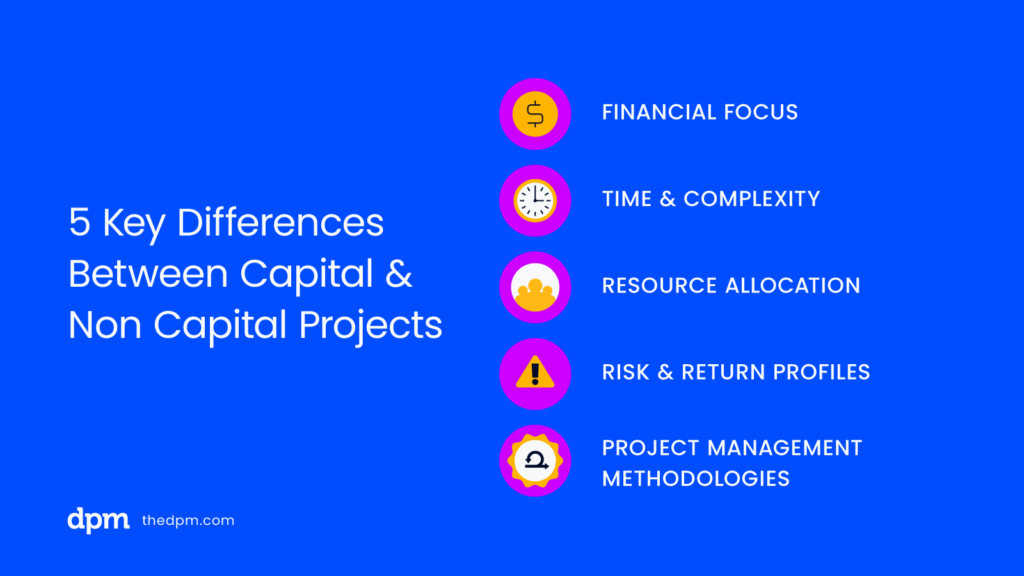In this piece I unpack what constitutes a non-capital project and some of the unique features that differentiate capital projects and non-capital projects.
I’m Mark Machin, and I lead a consulting practice within a large Canadian professional services firm, advising organizations and communities on strategic initiatives and projects.
While my work is mainly in the capital projects space, I sometimes contribute more broadly and assist with anything from IT infrastructure planning to organizational reviews and workforce strategy.
What Are Capital Projects?
Capital projects are about physical things—from developing real estate and changing community spaces, to planting forests or restoring wetlands. The majority are usually construction projects.
Usually these kinds of projects span multiple years and the costs are capitalized into tangible capital assets (the resulting products) with a useful life of multiple years. Check out this article on capital project management for a deeper dive!
What Are Non-Capital Projects?
In the realm of project management, a clear distinction exists between capital projects and non-capital projects. While capital projects primarily encompass construction endeavors, non-capital projects refer to projects where costs are not capitalized—they are not treated as capital assets on financial statements.
Non-capital projects cover a wide array of initiatives across various sectors, emphasizing efficiency, operational improvements, and organizational advancements without the need for significant capital investments.
They typically revolve around enhancing and streamlining workflows, implementing new technologies (as opposed to creating a new, tangible technology product), conducting research and development, or introducing organizational improvements.
Non-capital projects are usually about increasing productivity, reducing costs, improving customer satisfaction, or developing innovative solutions.
What is great about non-capital projects is their ability to create substantial value without the need for large financial outlays. Instead of allocating funds for new infrastructure or equipment, non-capital projects allocate resources toward process improvements, employee training, system upgrades, or market research.
Even still, non-capital projects still rely on sound planning and effective project management. And of course, excellent collaboration. They require a deep understanding of the organization's strategic objectives. Careful analysis and strong stakeholder engagement are also key in non-capital projects.
One of the key advantages of non-capital projects is their flexibility and adaptability. Capital projects require extensive planning and long implementation timelines, but non-capital projects can be planned and completed relatively quickly, and iteratively, often using alternative project management methodologies such as agile and Scrum. Expenditures in non-capital projects are often significantly lower in comparison to capital projects.
Non-capital projects also provide organizations the opportunity to foster a culture of continuous improvement. These kinds of projects optimize existing resources, processes, and systems, organizations can cultivate a mindset of innovation, efficiency, and operational excellence.
This focus on incremental advancements and cost-effective solutions contributes to a sustainable growth strategy and long-term success.
Examples of Non-Capital Projects
Capital projects are generally well-understood. However non-capital projects cover a pretty interesting and broad range. Here’s what you might expect from one:
- A marketing campaign for your company
- Improving a vendor payment system to reduce human error, time waste, and late payments
- An employee learning and development program
- A volunteer engagement initiative
- A digital transformation project
- A customer experience enhancement project
Non-capital projects cover a really broad range. One great thing I love about these kinds of projects is the innovative types of project management methodologies that can be employed to plan and execute them. Below are a few more unique distinctions.
You can find some examples of capital projects here.
5 Key Differences Between Capital vs Non Capital Projects

Capital and non-capital projects differ in their objectives, project cost, approach, and “feel”. Although all under the umbrella of “project management”, project managers looking after non-capital projects require quite different skills, and may derive a very different sense of job satisfaction from this type of work. Learn more about capital project managers here.
1. Financial Focus
Capital projects often have a primary focus on financial investment and return.
These projects involve substantial capital budgets and capital expenditures for new construction, renovation & expansion (capital improvement projects), or acquisition of capital assets and new facilities such as buildings, infrastructure, machinery, or equipment—it turns out these things cost a lot!
The success of capital projects is often measured in terms of financial metrics such as total project cost, return on investment (ROI), and payback period, inclusive of the operating budget.
On the other hand, non-capital projects shift the focus away from financial investments and prioritize other factors such as operational efficiency, process improvements, and organizational advancements.
Non-capital projects typically aim to optimize existing resources, systems, and processes rather than investing in new capital assets, and therefore incur much lower project costs.
Success in non-capital projects is evaluated based on non-financial metrics like improved productivity, customer satisfaction, employee engagement, or market competitiveness.
2. Time and Complexity
Capital projects are often characterized by their long duration, complexity, and extensive planning and construction processes. In the case of construction projects, they require careful feasibility studies, architectural designs, permitting, procurement, and construction management.
Due to their physical nature and larger scope, capital projects typically involve numerous stakeholders, intricate project schedules, and significant coordination efforts.
In contrast, non-capital projects tend to have shorter timelines and reduced complexity. Since they focus on improving existing operations or implementing incremental changes, non-capital projects can be initiated, executed, and completed relatively quickly.
They often involve smaller teams, simpler decision-making processes, and more flexible project management approaches, enabling organizations to respond swiftly to changing needs or emerging opportunities.
3. Resource Allocation
Capital projects require substantial financial resources and clear identification of project funding sources. Some of these costs include things like land acquisition, professional consultants, construction materials, equipment, labor, and other significant expenditure.
These projects often involve securing external financing. Another unique consideration is budgeting for long-term capital investments, and carefully managing cash flows throughout the project's lifecycle and the apportionment of operating costs. The allocation of financial resources is a critical aspect of capital project management.
In contrast, non-capital projects focus on optimizing existing resources rather than requiring significant capital investments. These projects may involve reallocating existing project budgets or identifying cost-effective solutions to achieve desired outcomes.
The resource allocation in non-capital projects typically revolves around human capital, process improvements, training, system upgrades, or market research rather than heavy financial investments.
4. Risk and Return Profiles
Capital projects are often associated with higher levels of risk and potential financial returns, due to their scale and longer duration. These pitfalls may include cost overruns, delays, regulatory changes, and market uncertainties.
However, successful capital projects can yield substantial financial returns - increased asset value, improved operational efficiency, or enhanced market positioning.
Non-capital projects, on the other hand, carry relatively lower financial risk since they involve fewer capital investments. Makes sense! However, they still entail inherent operational risks. Process changes, implementation of new technologies, or organizational disruptions can all be sources of risk.
The returns from non-capital projects are often realized through improved efficiency, productivity, customer satisfaction, or other non-financial benefits, which contribute to the organization's long-term success and sustainability.
5. Project Management Methodologies
Capital projects often employ structured and well-defined project management methodologies, like waterfall. These methodologies emphasize comprehensive project plans, cost estimates, detailed work breakdown structures, risk management frameworks, and rigorous change control processes.
The focus is on maintaining project scope, meeting quality standards, adhering to strict timelines, and managing cost overruns—pretty rigid!.
In contrast, non-capital projects may adopt methodologies like agile or Scrum. These approaches are particularly suited for projects that require iterative development, frequent feedback loops, and the ability to respond to evolving requirements.
Non-capital projects often prioritize flexibility, collaboration, and continuous improvement over rigid project plans. The emphasis is on delivering incremental value, fostering stakeholder engagement, and adapting to changing circumstances throughout the project lifecycle.
Non-capital projects also tend to embrace lean project management principles, which aim to eliminate waste, optimize processes, and improve efficiency.
This approach focuses on streamlining workflows, reducing unnecessary activities, and empowering project teams to make data-driven decisions to achieve project objectives effectively.
Furthermore, non-capital projects may leverage approaches from disciplines such as change management or process improvement methodologies like Six Sigma or Lean Six Sigma.
These methodologies provide frameworks for driving organizational change, optimizing business processes, and ensuring project outcomes align with strategic goals.
What’s Next?
Capital projects and non-capital projects can significantly differ in their nature, objectives, resource allocation, and project management methodologies.
Capital projects revolve around substantial financial investments, long durations, and complex construction processes, focusing on financial returns and asset creation.
On the other hand, non-capital projects prioritize operational efficiency, process improvements, and non-financial benefits, optimizing existing resources and achieving organizational objectives without heavy capital outlays.
The divergent project management methodologies employed reflect the unique requirements of each project type. Capital projects rely on structured frameworks for managing complexity, and non-capital projects embracing flexibility, collaboration, and continuous improvement.
Understanding these differences enables organizations to make informed decisions and select the most suitable approach to accomplish their project goals, whether it involves constructing physical infrastructure or driving operational advancements.
Ultimately, both capital projects and non-capital projects play essential roles in driving progress, innovation, and sustainable growth, shaping a future that balances financial success with social and organizational well-being.
Want to stay up to date and get the latest expert takes on project management as soon as they land? Subscribe to The Digital Project Manager newsletter here.


